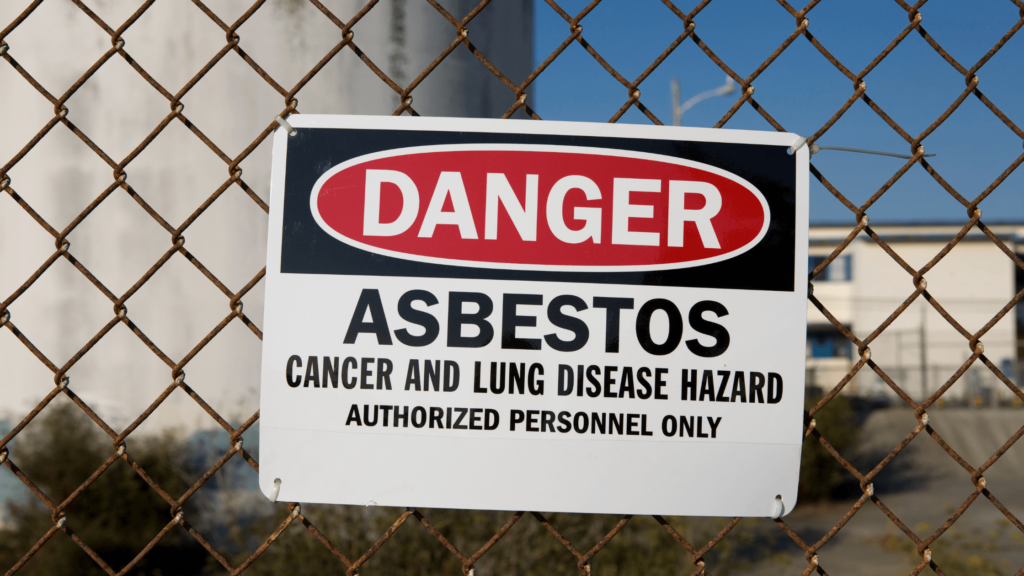Asbestos is a fibrous mineral often found in older building materials, such as insulation, floor, and ceiling tiles. Asbestos exposure can cause lung cancer, scarring of the lungs, mesothelioma, and other serious health problems—and workers are exposed to it by disturbing material that contains asbestos on job sites. Avoid exposure and reduce contact with asbestos materials through testing and proper PPE.
Quick look
- Older buildings often contain asbestos in the ceiling tiles, floor tiles, and insulation
- Workers who are exposed to asbestos are at higher risk of developing health issues such as lung cancer and mesothelioma
- Regular testing, abatement, and ensuring workers are equipped with the proper PPE are all vital to mitigating asbestos exposure
Asbestos is a fibrous mineral found in older buildings

Asbestos is a naturally occurring mineral used to insulate buildings from cold weather, noise, and fireproofing in decades past.
From the 1930s through the 1970s, asbestos was common in building materials, vinyl goods, and other construction products, meaning older buildings are likely to contain asbestos in some form.
Most workers gain exposure to asbestos during construction or renovation work, but some industries are at a higher risk than others. These include:
- Carpenters
- Drywall tapers
- Electricians
- Electric power linemen
- Insulators
- Painters
- Pipefitters
- Plasterers
- Plumbers
- Roofers
Hazards of asbestos exposure
Breathing in asbestos fibers can lead to severe illnesses such as lung cancer, asbestosis, mesothelioma, and emphysema or chronic bronchitis. But, since these illnesses are slow to show symptoms, it can take up to 15 years or more before workers feel the effects of their exposure.
Approximately 235,000 Canadians are exposed to asbestos at work, most of whom are in the construction industry. The largest exposed groups by trade are carpenters, with 36,000 workers exposed, followed by helpers and laborers, with 36,000 workers exposed, electricians with 21,000 workers exposed, and janitors and caretakers, with 19,000 exposed.
From 2006 to 2016, the number of workers exposed to asbestos increased by approximately 83,000.
But it’s not just Canadians. Roughly 38% of Americans have been exposed to asbestos at work in high-risk industries. Even worse, 47% of family members have been exposed indirectly. Indirect exposure carries the same risks as primary exposure, and in some cases, secondary exposure reaches occupational levels.
If you’re surprised, consider that exposure can happen even with the simplest of tasks, such as washing a family member’s work clothes. Direct contact or disturbing clothing, furniture, and carpets embedded with asbestos fibers can cause particles to become airborne.
Some symptoms of indirect exposure include:
- Chest pain or tightness
- Difficulty breathing
- Abdominal swelling or distention
- Clubbed fingers
But here’s the thing. Even with early screening for asbestos exposure, many workers retire before asbestos-caused lung scarring appears. This makes it hard to determine when they were exposed and for how long it’s been an issue.
Asbestos regulation and worker protection
Since 2018, Canada has prohibited the manufacture, import, sale, and use of asbestos products.
- Asbestos products in the US have been gradually phased out. As of March 18, 2024, a rule has been finalized to ban chrysotile asbestos, allowing a 12-year phase-out of the material used. It doesn’t ban all asbestos products, but is considered a major step in the right direction.
- OSHA has set regulations for permissible exposure limits (PEL) to protect workers with engineering controls, work practices, and proactive equipment to limit exposure.
Effects of asbestos exposure
Asbestosis
Asbestosis, also called diffuse pulmonary fibrosis, is a chronic lung condition that can develop years after asbestos exposure. It is caused by inhaling or ingesting asbestos fibers that can get stuck in the lung tissue, leading to inflammation and scarring over time. Asbestosis is not a type of cancer but can become more severe, creating a higher risk of developing mesothelioma or lung cancer.
Mesothelioma
Mesothelioma is a cancer caused by asbestos exposure through inhaling or ingesting it. The most common sites in which it develops are the pleural and peritoneal tissues (lungs and lining surrounding your abdominal organs). Still, asbestos fibers can also get lodged in internal organs and cause tumors. The life expectancy of mesothelioma ranges from 18 to 31 months with treatment like surgery and chemotherapy.
Lung cancer
Lung cancer from asbestos exposure develops in lung tissue with two main types: small cell lung cancer (SCLC) and non-small cell lung cancer (NSCLC). The Burden of Occupational Cancer in Canada project estimates 1,900 lung cancer and 430 mesothelioma cases each year from past exposures.
Creating a safer workplace

Regular asbestos testing
Asbestos isn’t present in every building, but those built before the mid-80s typically contain it. For contractors, hiring a qualified asbestos testing company is important. For older homes and buildings that have experienced flood or fire damage, it’s vital to test for asbestos, as disturbing contaminated materials could release asbestos fibers into the work area.
Asbestos abatement
Abatement involves identifying, removing, or encapsulating materials in a structure to eliminate or limit the threat of asbestos exposure by trained professionals. Hiring an asbestos removal company is the only safe and effective way to reduce or eliminate harm and worker or employee exposure. Be diligent in hiring a reputable abatement company to avoid fraudulent work that could put your workers at risk.
Don’t remove asbestos yourself
Do not attempt to remove asbestos materials on your own or by using unqualified employees. Hire specialists who can do the job safely and correctly to protect everyone in the surrounding environment.
Reducing the risks
Controls to consider on the job site to reduce the risk of asbestos exposure include:
- Eliminate or substitute asbestos materials whenever possible
- Modify facilities, processes, or equipment to encapsulate or enclose the hazard
- Implement administrative controls through work practices, awareness, and proper safety training
- Provide appropriate personal protective equipment (PPE) for workers
Common materials containing asbestos
While most construction industry people know that asbestos exists in older buildings, many aren’t clear on where it can be found. Here are some of the most common materials that contain asbestos:
- Drywall joint compound
- Vermiculite insulation
- Vinyl floor tiles
- Ceiling tiles
- Pipe duct insulation
- Ceiling texture coat
- Vinyl floor tiles
Other methods of asbestos exposure include:
- Sanding or breaking old floor or ceiling tiles
- Sawing or drilling of old plaster
- Removing old insulation from pipe wraps or duct wraps
- Removing old roofing shingles or roofing material
Working with the looming risk of asbestos
Although asbestos use is decreasing and, in some places, prohibited, the threat of exposure will always need to be considered. For crews working in older buildings, the protection of high-risk industry workers should be a top priority. Having a safety procedure in place to mitigate exposure through testing and the use of proper PPE while working around asbestos is critical to reducing its health impact.


